The U.S. will appeal the ruling of a Montenegro Court to hand Terraform Labs co-founder Do Kwon to South Korea, according to Bloomberg.
Crypto Backers B. Riley and Nomura Entangled in SEC Probe: Bloomberg
Investment bank B. Riley is under an undisclosed investigation from U.S. authorities for its deals with Brian Kahn, an alleged co-conspirator in a U.S. Department of Justice criminal case.
Spot Bitcoin ETFs Record Over $800 Million In Net Inflows in Debut Week – Details
On Wednesday, January 10, the US Securities and Exchange Commission (SEC) finally approved the launch of spot Bitcoin ETFs, representing a remarkable event in US trading history.
So far, market data on these investment funds have confirmed theories of increased institutional demand for Bitcoin, with over $800 million in total net inflows and $3.6 billion in trading volume recorded across the first two days of trading.
Although these inflows are yet to be reflected in BTC’s price, as the premier cryptocurrency dipped by 2% in the last week, the spot Bitcoin ETFs have certainly kicked off with a blast which is indicative of potential gains for the world’s largest asset and the general crypto market.
Spot Bitcoin ETFs Attract Over $1.4 Billion In Two Days – Bloomberg Data
In an X post on January 13, Bloomberg ETF analyst Eric Balchunas shared some insight on the impressive performance of the spot Bitcoin ETFs in their debut trading week.
Balchunas noted that of the 11 approved spot BTC ETFs, nine have recorded a total inflow of over $1.4 billion. Leading the lot is BlackRock’s IBIT, with an estimated asset inflow of $497.7 million, closely followed by Fidelity’s FBTC, which boasts about $422.3 million in investment.
The BTC spot ETFs of Bitwise and ARK/21 Shares have also produced a significantly positive performance attracting $237.9 million and 105.2 million, respectively. On the other hand, Grayscale’s GBTC has been the market outcast, recording a stunning $579 million in outflows over the first two days of trading.
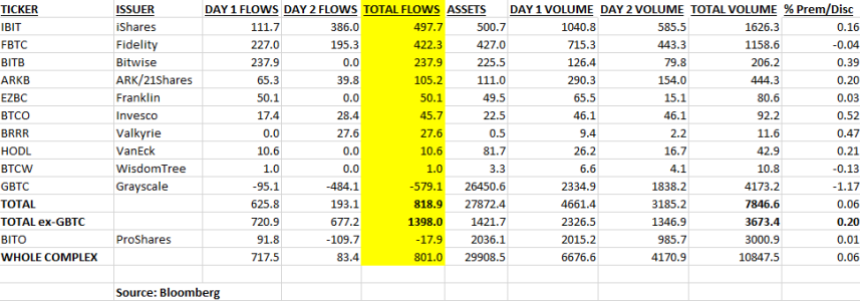
Following the SEC’s approval on Wednesday, investors cashed in heavily on GBTC, which was recently converted from a closed-end fund to a spot ETF. SkyBridge Capital founder Anthony Scaramucci has already commented on this trend describing it as one of the potential reasons behind Bitcoin’s dip in the last week.
In total, the spot Bitcoin ETF market recorded an impressive net inflow of $818.9 million in its debut trading week. These figures are likely to improve in the next few weeks as selling volume eventually declines. Meanwhile, investors still anticipate the debut of Hashdex’s spot ETF – DEFI – which is undergoing fund conversion from the company’s Bitcoin futures ETF.
BTC Price Overview
At the time of writing, Bitcoin exchanges hands at $42,980 reflecting a 0.73% loss in the last day. Meanwhile, the token’s daily trading volume has plummeted by 62.33% and is now valued at $16.9 billion. However, with a market cap of $842.23 billion, Bitcoin remains the largest cryptocurrency in the world.
Featured image from Yahoo Finance, chart from Tradingview
Bitcoin options data shows whales betting big — Will $50K BTC come in January?

Institutional investor interest soars as Bitcoin options open interest hits record high.
BNB pops after report that DOJ wants $4B settlement with Binance

BNB hit its highest price since June after Bloomberg reported the Justice Department wanted $4 billion from Binance to end its probe into the exchange.
Grayscale ETH futures ETF a ‘trojan horse’ for spot Ethereum ETF: Analyst

Bloomberg ETF analyst James Seyffart thinks Grayscale’s Ether futures ETF application is just a ploy to corner the SEC to approve its spot Ether ETF.
3 reasons why Bitcoin price failed to break $37K

Bitcoin’s latest price pullback to $35,000 was driven by softer U.S. inflation, China’s economic challenges and regulatory uncertainties.
BlackRock’s spot Ethereum ETF plan is confirmed after Nasdaq filing

Earlier in the day, BlackRock registered corporate entity “iShares Ethereum Trust” in Delaware, the first hint that a filing for a spot Ethereum ETF filing was imminent.
Blockchain adoption continues unabated — Bloomberg analyst

Blockchain adoption has been “unabated” throughout bull and bear markets over the past years, says Bloomberg analyst Jamie Coutts.
Bloomberg Analyst Predicts Likelihood Of A Spot Bitcoin ETF By January 2024
Following notable changes to the ARK 21Shares Spot Bitcoin ETF application, Bloomberg ETF analysts James Seyffart and Eric Balchunas have predicted that the US Securities and Exchange Commission (SEC) could approve a fund as early as next year.
90% Chance Of Approval
In a post shared on his X (formerly Twitter) platform, Seyffart highlighted his team’s prediction of the 90% chance that a Spot Bitcoin ETF will be approved by Ark Invest’s January 10 deadline. January 10 is the day the SEC is expected to make a final decision (approval or denial) on ARK Invest’s Spot Bitcoin ETF application.
Their latest prediction comes amid the recent amendment ARK Invest and 21Shares made to their Spot Bitcoin ETF prospectus. These updates include further context to the fund and additional risk disclosures. These analysts believe that this sort of amendment only happens when a fund is on its way to being approved.
These Bloomberg analysts had earlier predicted (following Grayscale’s victory) that there was a 75% chance that the pending Spot Bitcoin ETF applications could be approved this year and that the odds would rise to 95% by the end of next year if these funds weren’t approved by then.
Eric Balchunas noted on his X platform that Invesco Galaxy had also amended its Spot Bitcoin ETF prospectus following the ARK 21Shares amendment. He stated that he expects other applicants to update their applications soon. This suggests that the SEC could approve all applications simultaneously, similar to what it did with the Ethereum futures ETFs.
Spot Bitcoin ETFs Given Huge Boost Following SEC’s Decision
Meanwhile, these Spot Bitcoin ETF applications were given a huge boost following the SEC’s decision not to appeal the court’s ruling in its case against Grayscale. The SEC had until October 13 to appeal the Court of Appeal’s ruling that it had acted arbitrarily and capriciously in disapproving Grayscale’s application to convert its GBTC fund into a Spot Bitcoin ETF.
Following its decision not to file an en banc application or appeal to the Supreme Court, Reuters reported that the appeals court is expected to issue a mandate laying out how the SEC could carry out its order, including the Commission reviewing Grayscale’s application again.
James Seyffart also noted that dialogue between Grayscale and SEC should begin next week. However, it remains uncertain if or when the SEC will approve these applications, especially considering that it has delayed its decision on all Spot Bitcoin ETFs till next year.
Bitcoin has reacted positively to the news of the SEC’s decision not to file an appeal, currently trading at around $26,849.76, up in the last twenty-four hours, according to data from CoinMarketCap.
12 people will decide the fate of former FTX CEO Sam Bankman-Fried

45 prospective jurors were narrowed down to 12 after they were asked to discuss their background, employment, education, partners, children and their age.
Will Bitcoin Price Crash To $10,000? Bloomberg Expert Reveals When
Many analysts have weighed on the potential trajectory of the flagship cryptocurrency, Bitcoin. This time, Bloomberg analyst Mike McGlone has highlighted the possibility of Bitcoin price declining further and when this could happen.
Bitcoin Price Could Decline Further
In a tweet on his X (formerly Twitter) platform, McGlone noted that Bitcoin risks declining to $10,000 (which could happen by year-end) as it continues to battle the $30,000 resistance level.
This resistance level has long been touted as the key to a sustained breakout in Bitcoin’s price. However, going by the analysis that McGlone shared, the odds seem to be against this happening.
Bitcoin has risen significantly in 2023, considering that the crypto asset traded at around $16,000 at the beginning of the year. But, McGlone warned that this may be a “short-covering rally.”
As part of this analysis, he noted that liquidity in the Bitcoin ecosystem remained negative heading into the fourth quarter. This ultimately means there is more selling pressure than buying pressure, which could affect Bitcoin’s price.
Another factor is the rising interest rates. McGlone noted that Bitcoin gained prominence in a “zero interest-rate world” with greater financial freedom. But now, Bitcoin (alongside other cryptocurrencies) might continue to endure a hangover as “global rates continue to rise.”
Global inflation is said to be on the rise, and to curb it, authorities are raising interest rates, which could restrict spending and, by extension, the liquidity that goes into the crypto market.
Meanwhile, the analysis noted Bitcoin’s importance in the grand scheme of things. Bloomberg Intelligence drew a correlation between the FED fund futures and Bitcoin’s price. According to projections, Bitcoin needs to decline further before there can be a liquidity reversal in those funds.
While the Federal Reserve may not care about Bitcoin, he stated that Bitcoin’s “24/7-traded, leading indicator status could be gaining traction.”
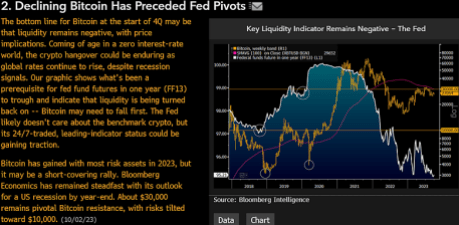
The Fate Of The Broader Crypto Market
In another tweet, McGlone noted that cryptocurrencies “might be leaning into recession.” To drive home this point, he highlighted the relation between the crypto and stock market and stated that the latter could succumb to an “ebbing tide” suppose the stock market were to experience a “typical drawdown” due to a recession.
Despite the “broader on-and-of-again fluctuations,” this projection is said to be reflected in the “downward trajectory” of the Bloomberg Galaxy Crypto Index (BGCI) and Russell 2000 Index (RTY) from their all-time highs in 2022. Both markets have remained tepid and continue to consolidate as they anticipate a “catalyst” that could spark a price surge.
This analysis is similar to that of crypto analyst Nicholas Merten, who, while drawing out the direct relation between both markets, noted that if the stocks of big tech companies like Apple and Microsoft don’t start picking up, there could be a “really big problem” for the crypto market.
Bonds Out, Bitcoin In? Bloomberg Analyst Predicts Major Portfolio Shifts
In a comprehensive evaluation of global market dynamics, Bloomberg Intelligence analyst and Chartered Market Technician (CMT) Jamie Coutts has opined on the shifting sands of financial asset volatility. With bonds potentially falling out of favor and Bitcoin cementing its place as a debasement hedge, traditional portfolio models may be on the verge of a renaissance.
Major Portfolio Shift Towards Bitcoin?
Coutts tweeted, “It looks like we are about to see a substantial uptick in volatility across all markets, given where yields, USD, & global M2 are heading. Despite what lies ahead, there has been a big shift in the volatility profiles of global assets vs. Bitcoin over the past years.”
A comparative analysis by Coutts highlighted that since 2020, the volatility profiles of Bitcoin and Gold have declined, while most other assets have seen an increase in volatility.
His breakdown indicates that the traditional 60/40 portfolio volatility is up by 90%, NASDAQ’s volatility has surged by 53%, and global equity volatility rose by 33%; meanwhile, only Bitcoin’s volatility decreased by 52% as well as Gold’s volatility, which went down by 6%
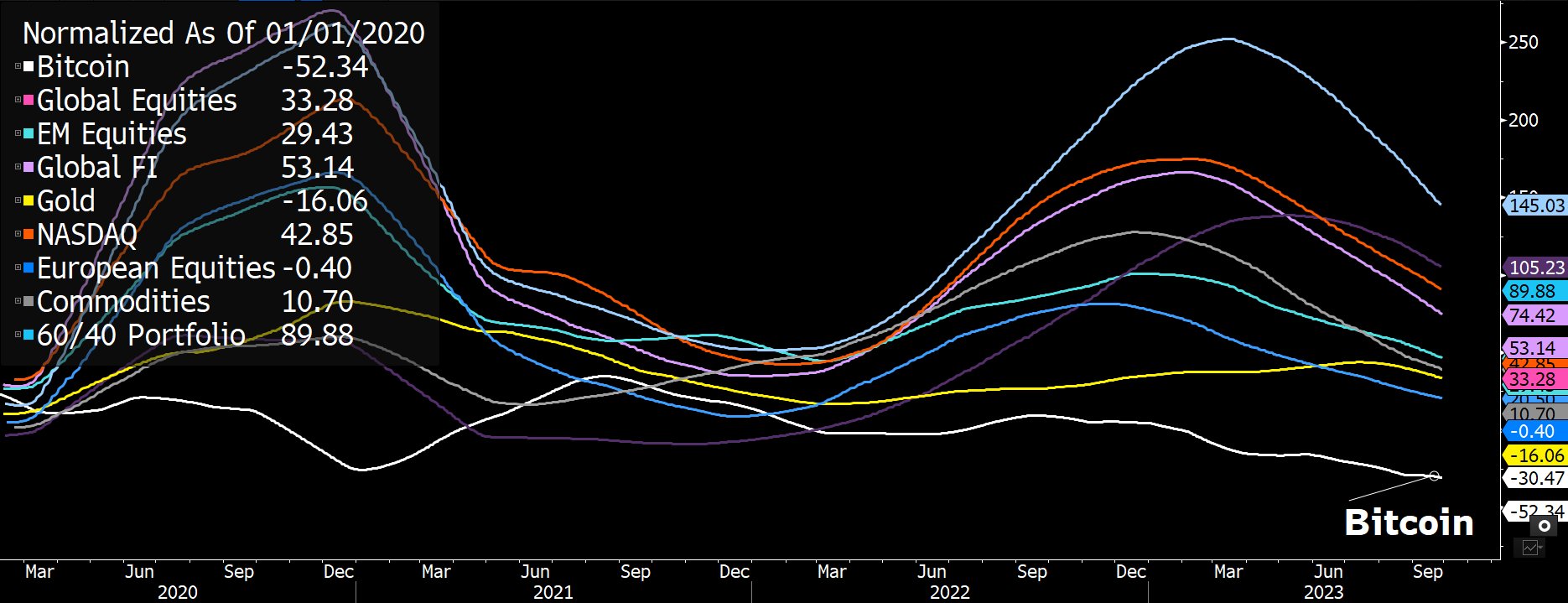
Coutts further elaborated that following the “hyper-volatile” phase of Bitcoin during 2011-14, the cryptocurrency’s volatility has been on a downward trajectory. From a peak above 120 in early 2018, this metric currently stands at 26.39.
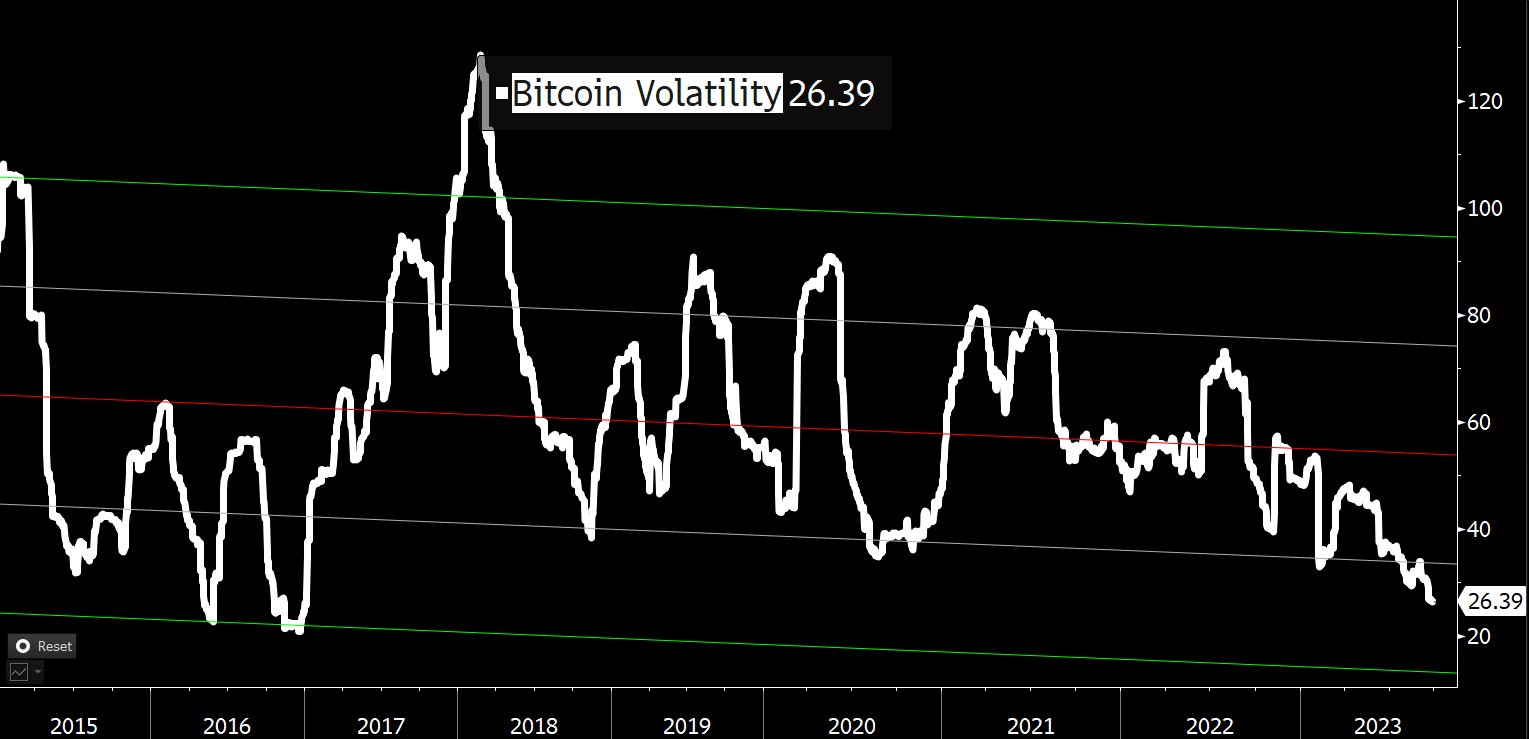
However, Coutts maintains skepticism over Bitcoin’s short-term prospects given the deteriorating macro environment: “Given that BTC volatility is near the bottom of the range plus a deteriorating macro environment: US dollar (DXY) is up, 10Y Treasury Yield is up, Global M2 money supply is up. It’s difficult to see how BTC (& all risk assets) can hold up with this setup.”
BTC Vs. Global Asset Classes
On the bright side, from an asset allocation perspective, Coutts considers the real question to be whether “Bitcoin can add value as a risk diversifier & improve risk-adjusted returns.” Comparing the risk-adjusted returns using the Sortino ratio during the last bear market, Bitcoin’s performance is not the best.
In the 2022 bear market, Bitcoin’s Sortino ratio is -1.78, positioning BTC above global equities, the NASDAQ 100, and the traditional 60:40 portfolio. However, it trails the S&P 500 (-1.46), European Equities (-1.01), Gold (+0.1), Silver (+0.28), and commodities (+1.25).
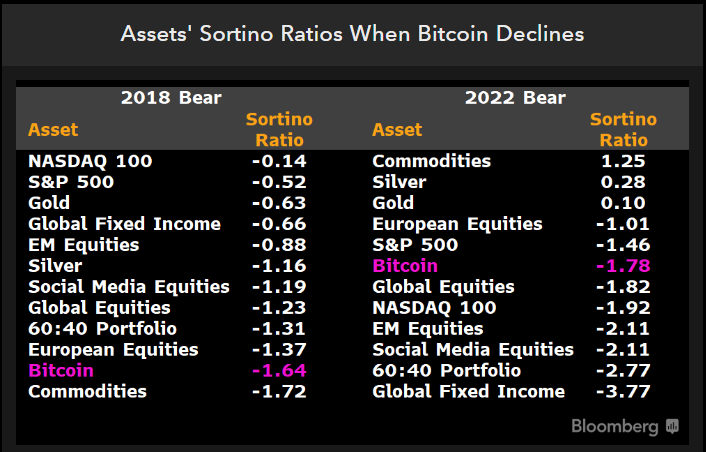
Elaborating on the cyclical behavior of Bitcoin, Coutts added, “The problem with BTC is the relatively short history makes inferences difficult and 1 year periods are certainly not significant. The best we can go on is multiple cycles. It’s clear that holding over the full cycle has been a winning strategy.”
Evaluating the Sortino ratio over the past three Bitcoin cycles (2013-2022), Coutts found Bitcoin to lead with a score of 2.46, outperforming the NASDAQ 100 (+1.37), S&P 500 (+1.25), and global equities (+1.05).
BTC: Top Bet Against Money Printing
In this scenario, Debasement concerns further enhance Bitcoin’s proposition. Coutts emphasized this saying, “And if allocators want to outpace monetary debasement, over most timeframes, bonds are not the place to be.” He identified Bitcoin as the foremost choice for portfolio reallocation against monetary debasement.
Citing the vast difference between asset returns concerning money supply growth (M2) over the past 10 years, he highlighted Bitcoin’s dominance with a staggering ratio of +8,598, followed by NASDAQ (+109), S&P 500 (+25) and global equities (-7.5).
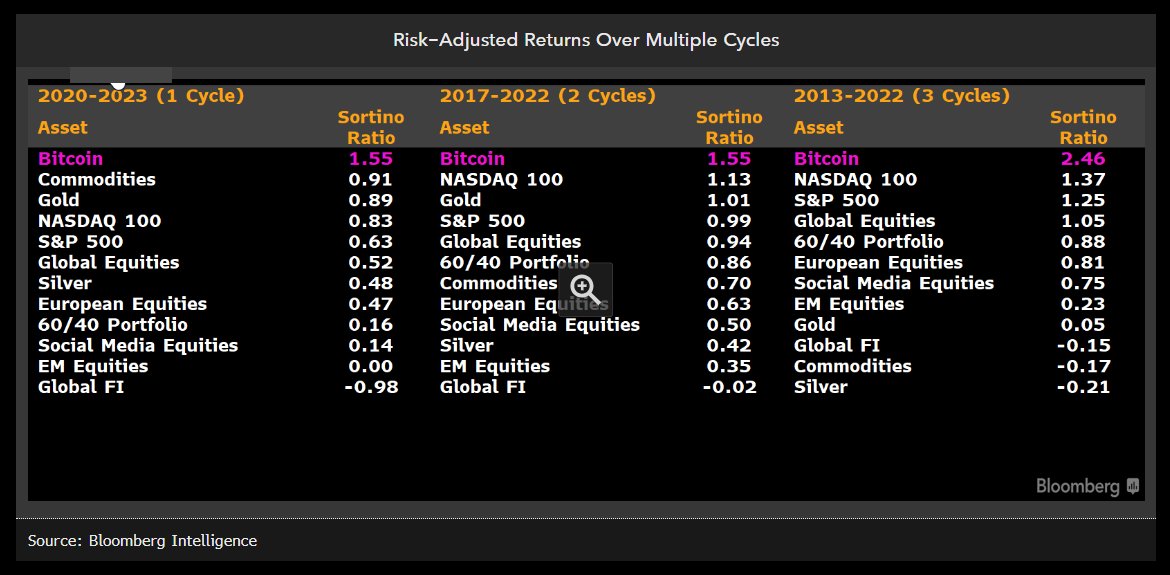
In a concluding statement, Coutts postulated, “In the years ahead it’s conceivable that allocators begin to shift towards better debasement hedges. BTC is an obvious choice.” Moreover, he suggests that Bitcoin could supplant bonds by securing at least 1% of the traditional 60/40 portfolio.
At press time, BTC traded at $26,433.
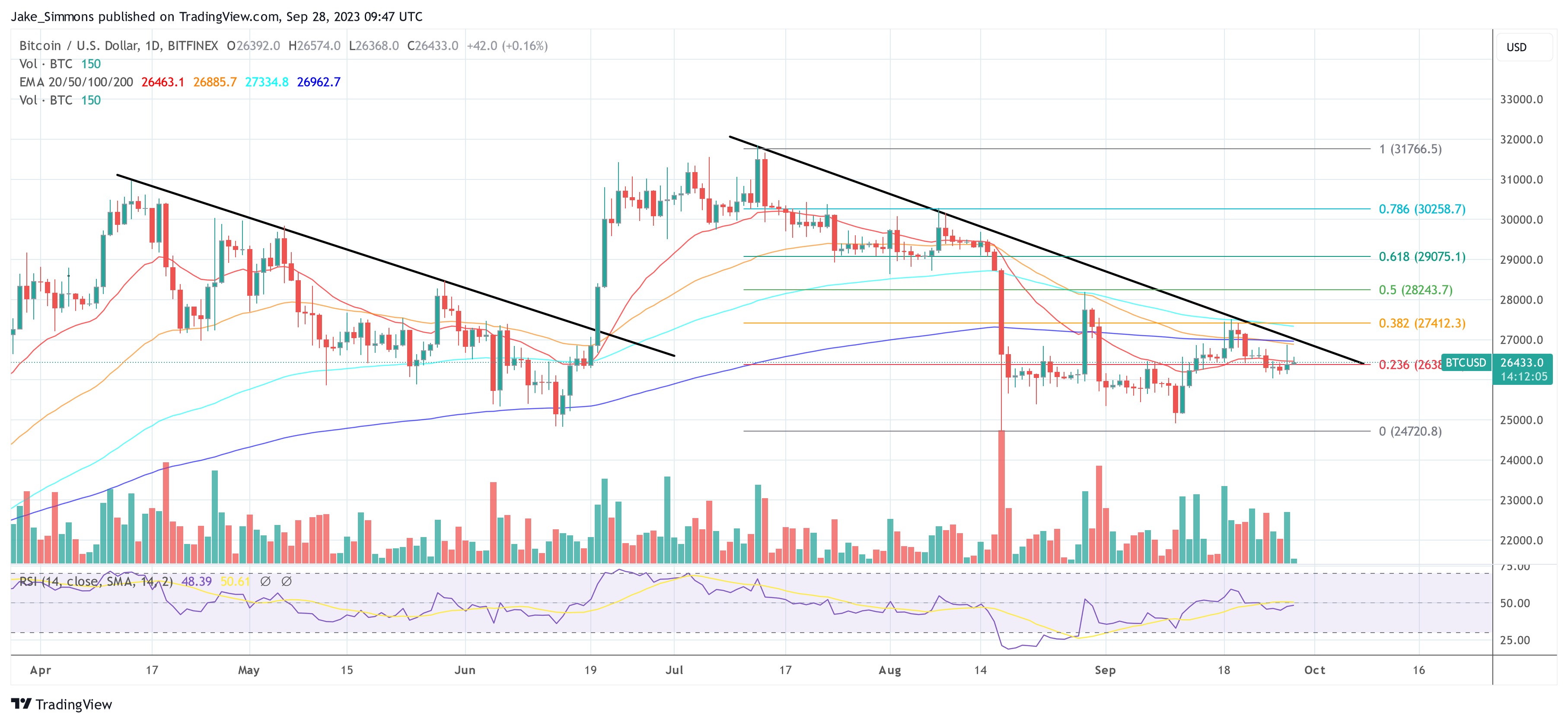
With All Eyes on a Spot Bitcoin ETF Approval, Don’t Sleep on ETH (or ETHE)
There’s a better trade than buying Grayscale’s GBTC if you’re optimistic the SEC will approve crypto ETFs.
Bloomberg Analyst Lauds Bitcoin Energy Shift Amid Rising Hashrate
The Bitcoin mining industry has risen steadily in the past few years thanks to the widespread adoption and increasing interest in the Bitcoin blockchain. This growth has led to a vast increase in Bitcoin’s hash rate, causing concerns regarding the carbon footprint left behind by mining activities.
A recent Bloomberg study has shown, however, that the carbon footprint left behind by the Bitcoin blockchain has stalled in recent years.
Bitcoin Unlikely To Burn The Oceans
It’s no news that Bitcoin mining is now a big industry on its own, with some mining firms even contributing to the economy and grid of their locations. Major BTC mining companies have also turned years of profits, which have attracted many investors, including large investment firms.
The issue of climate change and rising temperature have been the focus of many activists for years, with many accusing the energy-intensive activities of BTC mining of contributing negatively. As a result, regulatory agencies have been more insistent that mining corporations investigate safer and cleaner alternatives to fossil fuels for their energy needs.
To this end, Jamie Coutts, an analyst for Bloomberg, revealed that the percentage of Bitcoin transactions that use sustainable energy has increased steadily since 2021 and is now over 50%.
A new report has dropped on the Bloomberg @TheTerminal this morning – a further examination of this symbiosis between #Bitcoin mining and the global #EnergyTransition
— Jamie Coutts CMT (@Jamie1Coutts) September 20, 2023
This rise was particularly kickstarted by China’s ban on Bitcoin Mining in 2021 and Kazakhstan’s cap on the energy used by domestic crypto miners. Since then, the overall hash rate has increased by 286%, yet carbon dioxide emissions have decreased from 600 grams of CO2 per KWh to 296.5 grams of CO2 per KWh.
What Does This Mean For The BTC Ecosystem?
Bitcoin mining’s energy requirements take up around 50% of a miner’s operational cost. Cheaper clean energy is a way to offset these costs while simultaneously reducing the industry’s emissions or carbon intensity.
The Cambridge Centre for Alternative Finance (CCAF) also recently lowered its Bitcoin electricity consumption estimates by 25% from 105.3 TWh to 95.5 TWh, showing the transition is having better effects.
A transition into cleaner energy methods speaks well for BTC and the crypto industry as a whole, considering the blockchain has been heavily criticized in the past by environmentalists. This leaves room for companies to accept Bitcoin as a payment method without facing any kind of backlash.
Elon Musk’s Tesla, for instance, pledged in 2021 to resume allowing BTC payment for its cars when there’s a confirmation of 50% clean energy usage by miners.
Additionally, Climate technology venture investor and activist Daniel Batten argues that this metric is more than 50%.
Bloomberg Intelligence recently concluded that Bitcoin sustainable energy use has now surpassed 50%, contradicting Cambridge’s model.
Here’s a deep dive on why:
Cambridge’s model of Bitcoin emissions, which stopped updating in Jan 2022, states that Bitcoin is 37.6% from… pic.twitter.com/CP4QPmQvsb
— Daniel Batten (@DSBatten) September 18, 2023
On-chain analyst Willy Woo also estimates that the carbon footprint of the Bitcoin mining sector can be turned negative by an investment of around $450 million.
Here’s What Bitcoin Price The Bull Market Will Start According To This Analyst
The Bitcoin price has been experiencing a series of price fluctuations for two years now. The cryptocurrency has been on a bullish threshold multiple times but has failed to hold a bullish momentum for long.
Nevertheless, a Bloomberg analyst has predicted an unfeigned bull run for BTC, but the potential uptrend comes with certain factors and conditions.
Investors Prepare For Possible Bitcoin Bull Run
The slow growth of Bitcoin price has left investors and crypto enthusiasts hoping for a potential bull run since its crash in 2022, which saw the cryptocurrency dropping from $46,000 to below $20,000.
The morale of the crypto space has been uplifted, however, following a forecast made by Senior Macro Strategist at Bloomberg Intelligence, Mike McGlone, who proposes a potential bull run for Bitcoin.
In an X (formerly Twitter) post, the senior analyst implies that if the Bitcoin price rises above the $30,000 mark, investors should expect a significant bull run similar to the uptrend recorded in 2020 when Bitcoin was at its all-time high.
McGlone explained that Bitcoin’s $30,000 is analogous to its $12,000 price mark in 2020, just before its surge. To put this in perspective, in 2020, while Bitcoin price was as low as $12,000, the cryptocurrency recorded one of the highest surges in its history, and McGlone has equated that price jump to the bullish momentum he foresees for Bitcoin if it crosses the $30,000 price threshold.
“Bitcoin $30,000 May Be New $12,000, With Fed-Tightening Overhang,” McGlone said in the X post.
He also added that Bitcoin’s price may see substantial growth if regulatory burdens are addressed and spot Bitcoin ETFs are eventually approved.
“The inevitable approval of Bitcoin ETFs in the US is moving closer, but the elephant in the room for all risk assets remains. The Fed is still tightening despite the tilt toward economic contraction,” the analyst said.
Factors Hindering Bullish Momentum For The Bitcoin Price
As the crypto space keeps an eye out for more confirmation of a favorable price reversal for Bitcoin, several factors could impede Bitcoin’s expected growth trajectory.
Industry experts have highlighted that the increased adoption of the Bitcoin ETF following Grayscale’s victory against the SEC could have a significant impact on the price of Bitcoin. However, the United States Securities and Exchange Commission (SEC) previously rejected applications for spot Bitcoin ETFs by prominent financial service firms and crypto exchanges in the industry.
The SEC has also delayed applications for Bitcoin ETF from renowned firms like Blackrock, and WisdomTree even after Judges from the District of Columbia Court of Appeals in the US were not in favor of the SEC’s rejection of Grayscale’s Bitcoin ETF.
Furthermore, the SEC has also been aggressively suing many crypto exchanges, including Binance and Coinbase. This lack of a proper regulatory framework has affected the prices of cryptocurrencies, including Bitcoin, so crypto investors are hesitant to invest in an exchange facing multiple lawsuits and potential legal repercussions.
Bitcoin’s transaction volume has also taken a hit, plunging to 3-year lows. The transaction volume declined by a staggering 90% previously cutting short a potential rally and positioning the cryptocurrency at a bearish mark. Additionally, Bitcoin mining which was once a lucrative crypto venture has also seen a significant decline for participants.
However, while the factors hindering a Bitcoin price growth spurt are considerable, investors’ hopes still remain strong as they prepare for a price spike.
Bitcoin Rollercoaster: Analyst Forecasts $8,000 Dip Before Skyrocketing To $200,000
In his recent interview, Mike McGlone, Bloomberg Intelligence’s Senior Commodity Strategist, predicted Bitcoin’s potential fall amid the ongoing market downturn. However, it wasn’t all gloom from the seasoned analyst, as he also touched upon the longer-term prospects of the flagship cryptocurrency.
Will Bitcoin Touch $8,000?
It is worth noting that Bitcoin has undergone a fair share of price fluctuations since its inception. In the interview, McGlone compared Bitcoin’s volatile nature to the days of the stock market. His predictions, grounded in his analytical observations, also prompted apprehension and agreement.
Mike McGlone’s interview was rife with insights into the cryptocurrency market, but one statement stood out: his belief that Bitcoin could plunge to a low of $8,000 in the current bear market.
McGlone emphasized that despite the potential for such a drastic drop. Bitcoin remains the world’s top-performing asset. McGlone stated that Bitcoin hasn’t exhibited deflationary characteristics like Treasury bills and gold.
Instead, he pointed out that macroeconomic elements, particularly the Federal Reserve’s ongoing tightening policies, continue to have a pronounced effect on Bitcoin’s price.
Institutional Influence: Not the Immediate Boost Many Anticipate?
Another popular belief within the crypto community is that spot ETF approvals, and an influx of institutional investors would catapult Bitcoin’s price to new heights.
McGlone, however, expressed skepticism regarding this sentiment. In his view, while a spot ETF approval may sway market sentiment, it might not substantially impact Bitcoin’s price trajectory. McGlone suggested that the earliest spot ETF might not see daylight until next year.
On which spot ETF could potentially make the first move, McGlone’s bet is on BlackRock. Citing the institution’s commanding presence in the market and its reputation as the world’s leading asset manager, he believes BlackRock might lead the pack in the spot ETF space.
McGlone maintained confidence in Bitcoin’s long-term bullish prospects despite these short-term projections. He reaffirmed his vision of the crypto giant eventually reaching a value of $200,000.
Meanwhile, following the announcement of Grayscale’s legal victory against the US Securities Exchange and Commission (SEC), Bitcoin has retraced noticeably from its Tuesday peak of $27,974, dropping to $26,885 at the time of writing.
Bitcoin’s daily trading volume has also dipped along with its price, dropping from last Thursday’s peak of $12 billion to $10 billion in the past 24 hours. Notably, Bitcoin’s market cap currently sits at $523 billion when writing.
Featured image from Unsplash, Chart from TradingView
Bloomberg Analysts Raises Approval Chances Of Spot Bitcoin ETF To 75%
Bloomberg senior analysts Eric Balchunas and James Seyffart have raised their approval odds of the first Bitcoin spot exchange-traded fund (ETF) in the United States (US) to 75%.
This development comes after the US District of Columbia Circuit ruled against the US Securities and Exchange Commission (SEC), stamping out the regulator’s denial of Grayscale’s conversion of its Grayscale Bitcoin Trust (GBTC) into a Bitcoin ETF.
Court “Unanimity And Decisiveness” Unexpected, SEC Now In Tight Spot, Analysts Say
According to his X post on August 30, Eric Balchunas explains that the new stance from him and his colleague was based on certain developments in Grayscale’s case against the SEC.
Related Reading: US Bitcoin ETF Approval Could See North America’s ETF Volume Rise To 99.5%
Although the Bloomberg analyst stated that a Gracyscale victory had been factored into their last 65% approval odds of a Bitcoin spot ETF, the court’s “unanimity and decisiveness” in ruling against the SEC was quite unanticipated.
NEW: @JSeyff & I are upping our odds to 75% of spot bitcoin ETFs launching this yr (95% by end of '24). While we factored Grayscale win into our prev 65% odds, the unanimity & decisiveness of ruling was beyond expectations and leaves SEC w "very little wiggle room" via @NYCStein pic.twitter.com/IyEGmWjuHa
— Eric Balchunas (@EricBalchunas) August 30, 2023
Furthermore, Balchunas explains that the SEC now faces a PR loss as Grayscale’s victory received media coverage from top media firms across the country. Combining this situation with the recent court defeat, the commission’s denial of the Bitcoin spot ETF will be “politically untenable.”
In their official report, both Balchunas and Seyffart also highlighted that the SEC’s dilemma worsens as it faces its first deadlines on seven Bitcoin spot ETF applications between September 1 and September 4.
However, following the recent court ruling, the Bloomberg analysts believe the securities regulator will likely give a delayed order.
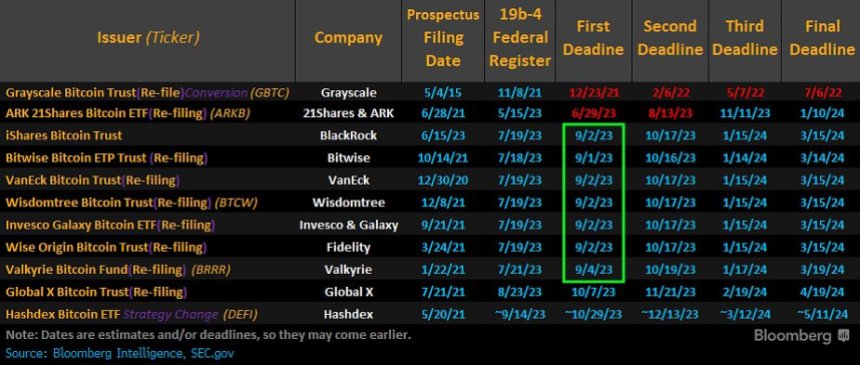
Finally, if the SEC is somehow able to deny all applications, the analysts state the financial agency will struggle to reject Hashdex’s unique proposal.
On August 25, the Brazillian asset manager filed to introduce a mixture of Bitcoin spot and futures ETF, secured by the Exchange for Physical (EFP) transactions, instead of a surveillance-sharing arrangement (SSA) with a crypto exchange.
Based on all the factors listed above, Balchunas and Seyffart rate the approval chances of a Bitcoin spot ETF in 2023 at 75%, with the potential of these odds rising to 95% at the end of 2024.
Bitcoin Poised For Massive Gains If Spot ETF Gains Approval
Following the influx of Bitcoin spot ETF applications in June, there has been much optimism about the potential effects these trading products could have on the premier cryptocurrency.
A Bitcoin spot ETF tracks the price of BTC, granting investors indirect exposure to the asset without the risks of direct investment in the cryptocurrency itself. According to hedge fund expert Tom Lee, a spot ETF will likely create a high demand-to-supply ratio of the largest crypto asset, pushing its prices of BTC as high as $185,000.
Related Reading: Ethereum ETF Race Gets Hotter As SEC Receives 11 Filings In One Week
The market leader rose by over 7% following Grayscale’s court victory to trade at $27,974.42, according to data from Coingecko. However, BTC soon experienced a price correction, finding support around the $27,000 price zone.
At the time of writing, Bitcoin is trading at 27,229.89 with a 0.9% loss in the last day.
Tether adds Bahamas-based private bank Britannia as partner: Report

Tether’s reported new partnership with Britannia Bank makes it the third Bahamas-based bank to join forces with the stablecoin issuer.
The Aura Around PEPE Isn’t Good For The Market, Especially Bitcoin – Here’s Why
Pepecoin (PEPE) has been exhibiting a surprising level of calm in its price movement lately. However, contrary to what many may assume, this could be a red flag for Bitcoin (BTC) and the entire cryptocurrency market.
According to a Bloomberg report, when an asset experiences an extended period of calm, it can be a sign of market euphoria and an overheated market.
This raises concerns about the sustainability of the current market trend, especially in the context of the cryptocurrency landscape.
Let’s dive deeper into what an overheated market means and how it could impact the king of cryptocurrencies and the market as a whole.
PEPE And The Implications Of An Overheated Market
As reported by Bloomberg, the current market behavior of PEPE is causing concerns for the broader cryptocurrency landscape, particularly for Bitcoin.
This is due to the fact that the rise of PEPE was accompanied by a surge in speculative trading and a frenzy of buying activity, which could indicate market euphoria.
Coinciding with this, the alpha coin has experienced a drop in value and a period of consolidation.
When the market becomes overheated, it means that the prices of assets have risen to an unsustainable level, fueled by excessive optimism and speculation.
In such a scenario, investors tend to overlook the fundamental value of the assets and focus more on the potential for quick profits.

This results in a significant increase in demand, which drives up the prices further, creating a bubble that is bound to burst at some point.
In an overheated market, the prices of assets are often overinflated and do not reflect their true value.
This creates a risk of a sharp correction, which could result in significant losses for investors who have overvalued their investments.
Moreover, such a correction could lead to a chain reaction that could affect the entire market, causing panic selling and further price drops.
PEPE’s Correction, BTC’s Struggles Emphasize Asset Valuations In Volatile Markets
The report noted that the current drawdown in the cryptocurrency market has impacted investors’ ability to chase opportunities with other assets.
This means that investors are becoming more cautious and less willing to take risks, as they recognize the potential risks of an overheated market.
Despite PEPE’s impressive 2,8931% hike in the last 30 days, it has since corrected, indicating that investors are starting to be more mindful of market fundamentals.
PEPE’s price on CoinGecko currently sits at a measly $0.00000169, having undergone a 24-hour slump of 2.7% and a seven-day decline of 11.5%.
Meanwhile, BTC is currently priced at $27,207.23, experiencing a 24-hour slump of 0.8% and a seven-day decline of 1.9%, highlighting its recent struggles in maintaining its upward momentum.
The current behavior of PEPE and the decline of BTC serve as a reminder of the potential risks that come with overvaluing assets and ignoring fundamental values.
As the crypto market continues to evolve and attract more investors, it is essential to maintain a realistic perspective on asset valuations and not be swayed by market euphoria.
By doing so, investors can protect themselves from potential losses and contribute to a more sustainable and stable market in the long run.
(This site’s content should not be construed as investment advice. Investing involves risk. When you invest, your capital is subject to risk)
-Featured image from Ride Time
